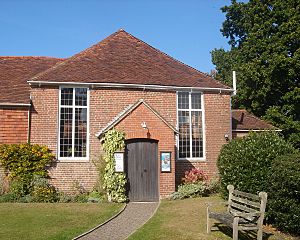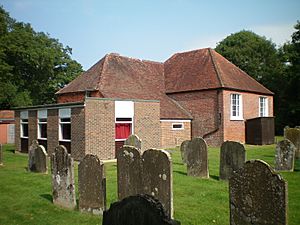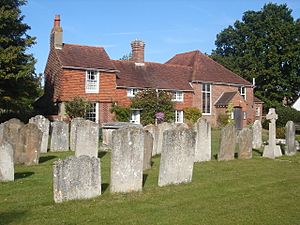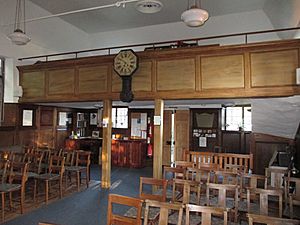Ditchling Unitarian Chapel facts for kids
Quick facts for kids Ditchling Unitarian Chapel |
|
|---|---|

The chapel from the east
|
|
| 50°55′18″N 0°06′47″W / 50.9216°N 0.1131°W | |
| Location | The Old Meeting House, The Twitten, Ditchling, East Sussex BN6 8UJ |
| Country | England |
| Denomination | Unitarian |
| Previous denomination | General Baptist |
| Website | ditchlingunitarians.org.uk |
| History | |
| Former name(s) | Ditchling General Baptist Chapel |
| Status | Chapel |
| Founded | 17th century (congregation); 1730 (present chapel) |
| Founder(s) | Robert Chatfeild [sic] |
| Architecture | |
| Functional status | Active |
| Heritage designation | Grade II |
| Designated | 27 September 1979 |
| Style | Vernacular |
| Groundbreaking | c. 1734 |
| Completed | c. 1734 |
The Ditchling Unitarian Chapel is a special place of worship in the village of Ditchling, located in East Sussex, England. It's also known as The Old Meeting House. This chapel started out in the 17th century as a meeting place for a group called General Baptists. Ditchling was a hub for people who worshipped differently from the main Church of England.
Over time, the chapel's beliefs changed. By the early 1800s, it had become a Unitarian chapel. This change caused some people to leave and start a new chapel nearby. Many interesting people have been connected to the Ditchling chapel, including famous writers and even a conductor. The chapel, its old house, and graveyard are important parts of Ditchling's history. Because of its special design and history, the chapel is a "Grade II" listed building.
Contents
A Look at the Chapel's Past
In England, people who chose to worship outside the official Church of England were called Dissenters or Nonconformists. This became more common after 1662, when many ministers left the Church of England because they disagreed with new rules. These groups focused on a personal connection with God, rather than strict church ceremonies. This idea spread across Sussex, leading to many new religious groups.
Ditchling: A Center for Different Beliefs
Ditchling was a key place for these Nonconformist groups. Records from 1676 show that 64 people in the village were Nonconformists. By 1724, about 25 families out of 80 identified as Anabaptists, a term often used for various Baptist groups. One such group was the General Baptists. They believed that God's forgiveness was available to everyone, not just a select few. This was different from another belief called Calvinism, which suggested only certain people were chosen for salvation.
A General Baptist group was active in Ditchling by the late 1600s. People came from many places, even far-off towns like Sevenoaks in Kent and Crawley in Sussex, to worship here. At first, they didn't have a special building. They might have met in a cottage built in 1672, or another house registered for worship in 1716.
Building the Chapel
The current chapel was started by Robert Chatfeild, who was born in Ditchling in 1675. In 1730, he bought the land next to the 1672 cottage. Some records suggest the chapel was built around 1740, but Robert Chatfeild's will from 1734 shows it was already there by then. William Evershed, an important Nonconformist leader, preached there in 1736. Robert Chatfeild's son later took ownership of the land in 1740 and gave it to the chapel's trustees.
The first official record of the chapel itself is from 1737, when a list of new members was started.
The Shift to Unitarianism and a Split
Many General Baptist groups in Sussex, including Ditchling, began to change their beliefs in the 1700s. They moved towards Unitarianism, which emphasizes one God and personal interpretation of the Bible. By 1762, the Ditchling chapel was fully Unitarian.
However, not everyone agreed with this change. Some members preferred the older, more traditional Baptist views. In 1762, a member named Henry Booker heard a Calvinist preacher and decided to leave the Ditchling chapel. He and several others started a new Strict Baptist chapel nearby in Wivelsfield. This new chapel, called Bethel Chapel, is still used today.

Graveyard and Schools
The Ditchling chapel was built in a field called Gunsfield. In 1821, most of this land became a graveyard, replacing an older, full burial ground. The oldest gravestones in the original section date back to 1730 and 1731.
Around 1815-1816, Robert Chatfeild junior's sons used some of the Gunsfield land to build two free schools, one for boys and one for girls. These schools were supported by the chapel and donations. They were quite successful for a while, with many Ditchling children attending. However, they faced financial problems and closed around 1836 when a new school opened in the village.
The cottage from 1672, which is next to the chapel, was made bigger in 1808. The new part was built with brick and tiles and was taller than the original. It was home to the chapel's Elder, who later became the schoolmaster.
Chapel Today
The Ditchling Unitarian Chapel has been Unitarian since the 1700s. Sometimes it has been called a Unitarian and Free Christian chapel. This means that members don't have to follow a strict set of beliefs. They believe the Bible and their own understanding of it are their main guides. Services are held on Sunday mornings.
The chapel has been a place for marriages since 1837. The famous conductor Sir Adrian Boult was married there in 1933. Other notable people, like author William Hale White (who wrote as Mark Rutherford) and writer G. K. Chesterton, also had connections to the chapel.
Why the Chapel is Important
The Ditchling Unitarian Chapel and the house next to it were officially listed as "Grade II" buildings by English Heritage in 1977. This means they are considered "nationally important" and have "special interest" because of their architecture and history. As of February 2001, it was one of many listed buildings in the Lewes district.
The local council says that Ditchling village center is special partly because of its long history of Nonconformist worship. The Unitarian chapel, along with a Quaker meeting house and another chapel, are important parts of this history. The chapel's graveyard is also seen as a beautiful and important open space in the village.
Chapel Design and Features
The chapel and cottage are set back from East End Lane on slightly higher ground. Like many Nonconformist chapels in Sussex, it is built of brick with a tiled roof. The brickwork is in a pattern called English bond.
The main entrance used to be on the north side, but it was bricked up in 1819. A new entrance was made on the east side in the 1800s, with a porch added in 1877. The windows are simple and have rounded tops.
Inside, the chapel is about 22.5 feet by 33.75 feet. Its current look comes from changes made in 1877. There's a wooden gallery (a balcony) at one end. The roof has a special design called a king post type. Inside, you can see a Communion table from the 1600s and wooden pews. There's also an old clock from the 1700s that came from another chapel.
There are memorials inside and outside the chapel. One stone inside remembers Michael Marten and his family. On the outside north wall, there are stones for Josiah and Sarah Dancy.
The cottage next to the chapel was built in 1672. It has two floors, with brick on the bottom and tiles on the top. The part added in 1808 is similar in style.
See also




